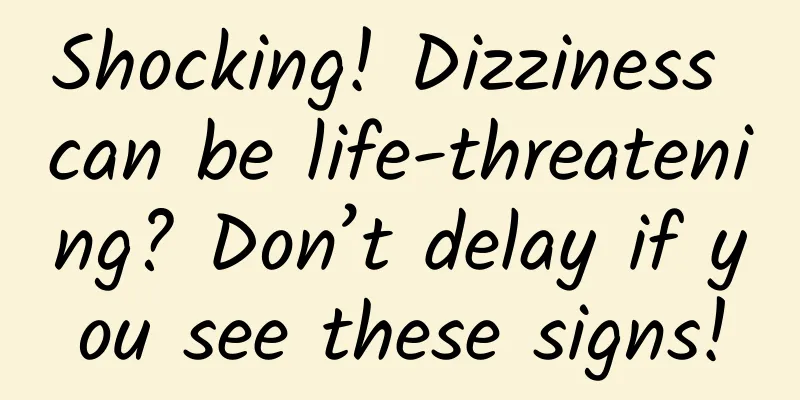Shocking! Dizziness can be life-threatening? Don’t delay if you see these signs!

|
In daily life, dizziness and vertigo are very common symptoms, and when vertigo occurs, it is likely to affect our work and life. Fan Jianhu, deputy chief physician of the Department of Neurology (Encephalopathy) at the Hunan Provincial Hospital of Integrated Traditional Chinese and Western Medicine (Affiliated Hospital of Hunan Institute of Traditional Chinese Medicine) , said that generally speaking, most vertigo attacks will not cause very serious consequences, but we must be wary of one type of vertigo - dizziness/vertigo caused by posterior circulation ischemia, which may have serious sequelae, leading to inability to take care of oneself in daily life, or even death. Recently, Mr. Li, a 47-year-old fitness enthusiast, experienced this kind of dizziness. When he was exercising in the gym, he suddenly felt dizzy, the equipment in front of him was blurred and doubled, and he couldn't stand steadily. After resting for half an hour, the symptoms were relieved and he wanted to continue exercising. His friends thought something was wrong and tried their best to persuade him. Mr. Li, accompanied by his family, went to the Department of Neurology (Department of Encephalopathy). Deputy Chief Physician Fan Jianhu asked about Mr. Li's symptoms and found that he had dizziness, diplopia, and unstable posture. He also had a history of hypertension for more than 5 years and often forgot to take antihypertensive drugs. Considering the symptoms, the possibility of posterior circulation ischemia was considered high, and it was recommended to complete the cranial vascular assessment and hospitalization. Mr. Li felt that he had no symptoms and felt that he was young, so he refused the examination and asked to go home. That night, Mr. Li suffered another vertigo attack, and the symptoms worsened. He had slurred speech and difficulty swallowing, and soon his limbs became paralyzed. He was sent to the hospital again by 120. When he arrived at the hospital, it had been more than 6 hours since the onset of the disease. Emergency CTA showed that the main trunk of the basilar artery was occluded, and the time window for thrombolysis had been missed. Fortunately, after examination, the thrombus could be removed intravascularly. Although his life was saved, he was left with serious sequelae and could not take care of himself. 1. What is posterior circulation ischemia? Director Xie Le of the Department of Neurology (Encephalopathy) introduced that posterior cerebral circulation ischemia (PSCI) refers to ischemic lesions in the posterior circulation of the brain (vertebral basilar artery system). The posterior circulation supplies the back of the brain, including the cerebellum, brainstem, occipital lobe and temporal lobe, so posterior circulation ischemia may lead to severe neurological dysfunction. 2. What are the causes of posterior circulation ischemia? Atherosclerosis: The most common cause of the disease, lipid deposition in the blood vessel walls leads to blood vessel narrowing and blockage. Cerebral vasospasm: Sudden constriction of blood vessels, resulting in reduced blood flow. Thrombosis: A blood clot breaks off from the blood and blocks a blood vessel. Heart disease: Heart disease such as atrial fibrillation may cause emboli to break away and cause cerebral embolism. 3. What are the symptoms of posterior circulation ischemia? Vertigo and dizziness: Patients feel that their surroundings or themselves are spinning, often accompanied by nausea and vomiting. Visual impairment: loss of visual field, blurred vision, double vision, etc. Limb weakness: weakness in one or both limbs and uncoordinated movements. Language disorders: slurred speech and difficulty understanding. Impaired consciousness: Severe cases may cause confusion or even coma. 4. What examinations are needed for posterior circulation ischemia? 1. Head computed tomography (CT) This is the first test done and can quickly assess brain structure and detect signs of acute ischemic stroke, such as low-attenuation lesions. 2. Magnetic resonance imaging (MRI) MRI can provide more detailed brain images and help diagnose posterior circulation ischemia, especially showing early ischemic changes and the extent of cerebral infarction. 3. Magnetic resonance angiography (MRA) MRA is a non-invasive imaging technique used to assess the patency of cerebral blood vessels and can detect vascular stenosis or occlusion. 4. Digital Subtraction Angiography (DSA) DSA is an invasive test that provides detailed images of blood vessels and is used to diagnose narrowing or blockage. 5. Carotid Doppler Ultrasound Although it is primarily used to assess carotid blood flow, it may also be used as an adjunct to testing in patients with symptoms of posterior circulation ischemia. 6. Electrocardiogram (ECG) To evaluate heart condition because certain heart problems may increase the risk of ischemia. 7. Blood test Including blood cell count, coagulation function test, blood lipid level, blood sugar level, etc. to rule out other factors that may cause ischemia. Your doctor may decide which tests are needed based on your symptoms, medical history, and initial examination results. Often, a combination of tests is needed to get the most complete diagnosis. 5. What are the treatment options for posterior circulation ischemia? In acute treatment, time is of the essence. The earlier you come to the hospital, the more treatment options you have, and the better the prognosis. In addition to conventional oral medications, we can perform intravenous thrombolysis, mechanical thrombectomy and other treatments within the time window. For example, intravenous thrombolysis is a treatment option that can be selected within 6 hours of onset. If you miss the time, you will miss this very effective treatment option. Experts advise Professor Wu Dahua, leader of the encephalopathy discipline, reminded: Although posterior circulation ischemia sounds complicated, it can be well controlled through correct understanding and timely treatment. We call on everyone to pay attention to their own health, actively control basic diseases such as hypertension, diabetes, and hyperlipidemia, quit smoking and limit alcohol, exercise moderately, strengthen physical fitness, eat a light diet, maintain good living habits, and have regular physical examinations. Let us protect every wonderful journey of the brain together! Hunan Medical Chat Special Author: Fan Jianhu and Deng Lanju, Department of Neurology (Encephalopathy) of Hunan Provincial Hospital of Integrated Traditional Chinese and Western Medicine (Affiliated Hospital of Hunan Institute of Traditional Chinese Medicine) Follow @湖南医聊 to get more health science information! (Edited by Wx) |
<<: Wake up to a different face? Uncover the symptoms and daily care of facial paralysis
Recommend
How many days does it take for the cough to turn into white lungs? On which day should a CT scan be done? If you have these signs, go to the hospital immediately →
In just one week, the 8-year-old girl developed a...
Vulva itching at night
Vulvar itching is a common gynecological disease ...
The Battle to Defend Banana
This is the 4829th article of Da Yi Xiao Hu Many ...
Three months pregnant belly picture
1. Physiological abdominal pain. For example, the...
What to do if women have no sexual desire
Some women experience sexual apathy and have no d...
What should you pay attention to after painless abortion
Artificial abortion is a vacuum aspiration proced...
Why does eating an orange taste bitter after brushing your teeth?
If you eat an orange or drink a glass of orange j...
Night vomiting during early pregnancy
After pregnancy, women have to face many changes ...
What to do if you have bleeding 40 days after delivery
It is normal for mothers to bleed after delivery....
Stomach tightness and hardness after spotting
Before giving birth, some women will experience s...
Payments 2025 and Beyond: Exploring Future Trends in Payments
Pay for bus tickets with text messages in Türkiye...
How big does the egg have to be to be released?
The key to successful conception is not only havi...
Why does rock sugar reduce internal heat while white sugar increases internal heat? What is rock sugar made of?
Rock sugar is made by decocting white sugar. It i...
How to prevent uterine fibroids in life?
Preventing uterine fibroids is a very important t...
How do women maintain their ovaries?
With the rapid development of the economy, the pr...









